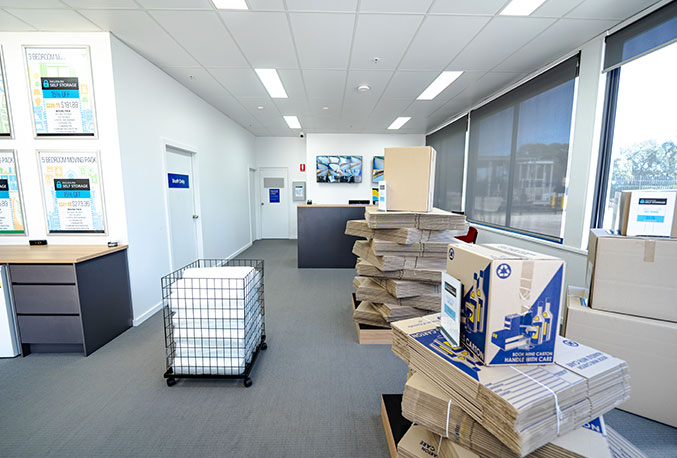Whether you're preparing for a move, decluttering your home, or just looking to free up some space, packing and storing personal items efficiently is essential. With the right approach, you can keep your belongings safe, organised, and readily accessible while in storage.
In this step-by-step guide, we’ll explain how to pack and store your personal items properly, so they stay safe and unspoiled during storage.
Step 1: Declutter & Sort
Before you start packing your personal items, take the time to declutter your drawers and cupboards. This process will help you determine what to keep, what to donate or sell, and what to store.
Once you’re clear on the items you want to store, separate them into categories. For example, summer clothing, winter wear, summer and winter sporting goods, books, kitchenware, collections, jewellery, sentimental items, and so on.
Step 2: Gather Packing Supplies
The quality of packing materials you use will have a huge impact on how well your possessions last in storage. To minimise damage and maximise protection, we recommend using only professional grade packing materials, including:
- Sturdy cardboard boxes in various sizes
- Plastic bins with secure lids
- Packing tape
- Bubble wrap or packing paper
- Packing peanuts or foam padding
- Markers for labelling
- Ziplock bags for smaller items.
You’ll find everything you need under one roof at our on-site box store.
Step 3: Pack Methodically
When it comes to preserving your stored items and making it easy to access them when you need to, you won’t regret following this tried and tested packing regime.
- Use appropriate sized boxes: Select the right-sized boxes for your items to prevent overloading or wasted space, i.e., use smaller boxes for heavier items, such as books, and larger boxes for lighter items such as duvets and pillows.
- Wrap fragile items individually: Protect delicate and breakable items by wrapping them individually in bubble wrap or packing paper. Place these items in boxes with ample padding. Tip: use tea towels or pillow slips for padding.
- Label all boxes and containers clearly: Make sure that an accurate description of the contents of each box is visible on the outside. Use marking pen directly on the box to stipulate the box number, contents, packing date and, if applicable, the room it belongs in. This will save you time and frustration when you’re unpacking.
- Create a print and digital inventory: As you’re packing, create a digital inventory of the items you’re storing, the box number, contents, packing date and position in the storage unit. Print out a copy and keep it in your storage unit for easy reference. Update your inventory regularly. This will help you keep track of what’s in each box and locate items more easily when you need them.
- Use transparent plastic bins: Consider using transparent plastic bins with secure lids for items you want to keep visible and dust-free. Note: Add desiccant sachets to these bins to prevent mould from forming inside the sealed containers.
Step 4: Maximise Space
Storage unit prices are based on the size of the unit, so it’s important to make optimal use of the space in your unit to save money and ensure that your unit is easy to navigate. Try these space-saving techniques:
- Make use of all three dimensions: Use shelves and stackable boxes to maximise use of vertical storage space.
- Use vacuum seal bags to compress bulky manchester: Clothes, duvets, bedding, pillows, and linens can be safely and easily compressed using vacuum seal bags. This will reduce the space they occupy, so you can store more items in less space.
- Disassemble furniture: Save space and prevent damage when storing larger furniture items, such as bedroom suites, by disassembling them into component pieces. Be sure to label the pieces and place any allen keys, screws, nuts and bolts in a labelled ziplock bag and tape it to the underside of one of the components.
Step 5: Climate-Controlled Storage
Climate control is essential when storing items that are sensitive to temperature and humidity fluctuations. To reduce the risk of damage to antiques, artwork, jewellery or other sensitive items, select a storage unit that is fitted with power so that you can install a suitable climate-controlled system, air conditioner or dehumidifier
Step 6: Accessibility
Follow these simple steps to ensure your stored items are accessible.
- Plan the layout of your storage unit to ensure accessibility: Organise your items in the storage unit with frequently needed items near the front of the unit so that they are easily accessible.
- Create aisle space: Leave aisles between rows of boxes to make it easy to reach items without having to move everything around.
Step 7: Security
Opt for individually lockable units: If keypad access control is available, be careful not to share your access code with just anyone. If standard locks are the order of the day, use a secure lock and safeguard the key to prevent unauthorised access.
Packing and storing personal items can be a daunting task, but with a systematic approach, it becomes more manageable. If you’d like to know more about how to safely store your personal items, reach out to our friendly team today.
Ready to get storing? Book your storage unit online today.


for Only $1 with a Minimum 2-Month Stay